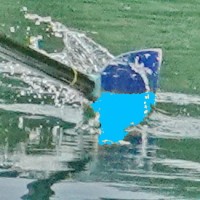Visualisation of Catch Factor and Blade Slip

Q: Carlo Zezza - a rowing writer and masters rower from Cambridge Boat Club, USA, asked us interesting questions: “To visualize a catch factor of -15 ms, would it be useful to estimate how far the seat moves toward the bow before the handle?”
A: During the optimal Catch Factor, seat moves to the now no more than 1.5cm. Only negative values of the Catch Factor below -50ms cause “slide shooting” more than 5cm, significant loss of legs power and a problem for other crew members.
The seat movement at catch vary in different rowers and at various stroke rates, so there is no singular relationship between seat displacement and its timing after catch. This Newsletter presents three extreme examples with various values of Catch Factor and legs speed.
During the target time of Catch Factor for sculling -15ms, the seat travels from 0.5cm in the Sculler 1 up to 1.0cm in the Sculler 3. At the target CF = -25ms for sweep, the range of the seat movement is 0.8 – 1.5 cm. These values were mentioned earlier in our publications as “quite small”. However, the seat velocity quickly increases after catch, so more negative values of CF cause much longer seat displacement during its time:
- CF = - 50ms can be related to the seat movement from 2 to 4cm depending on the rowing technique and stroke rate.
- CF = -80ms causes “slide shootings” from 4 to 8 cm, which is quite significant.
Q: Another question from Carlo Zezza was: “How deep do the best rowers plant the blade before the handle changes direction?”
A: In fact, when the blade changes direction at catch (its velocity relative to the boat becomes zero), it still moves forward relative to the water with the boat velocity at this moment. If the blade is “planted” into the water at this time, it would hit water with its back face producing a backsplash and braking force. The blade must be accelerated backwards up to certain velocity to hit the water with its front or achieve a neutral entry.
This Newsletter presents calculations and some reference values: the blade velocity relative water becomes positive after about 65ms after the catch and the handle travels only about 3cm or 2deg during this time. After it, the bottom of the blade can touch the water without backsplash.
Then, it takes another 60-70ms or 6cm= 4deg of the oar movement to bury the blade completely under the water (at target value 6deg of Catch Slip).
The directions to minimise the Catch Slip and avoid backsplash:
- Faster angular oar velocity and acceleration.
- Longer outboard.
- Lower the boat velocity at catch – another point in favour of the “boat check”.
- Longer catch angle: e.g. 10deg longer catch angle is about 26% more effective.
This is a short version of this Newsletter. Full text is available for BioRow members: https://biorow.com/membership/
©2023 Dr. Valery Kleshnev



